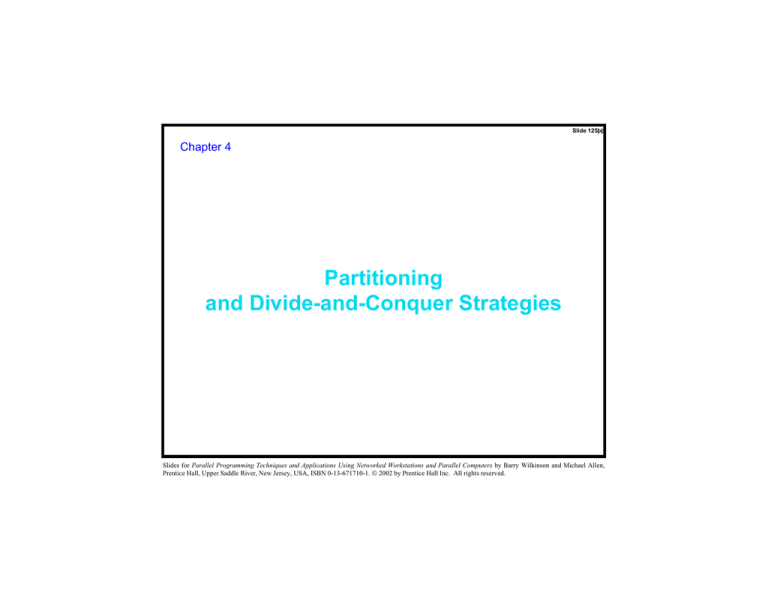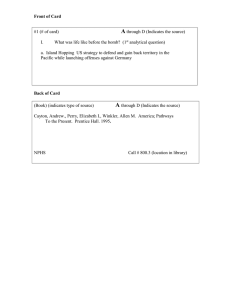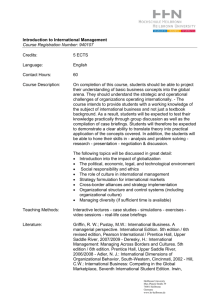
Slide 125þþ
Chapter 4
Partitioning
and Divide-and-Conquer Strategies
Slides for Parallel Programming Techniques and Applications Using Networked Workstations and Parallel Computers by Barry Wilkinson and Michael Allen,
Prentice Hall, Upper Saddle River, New Jersey, USA, ISBN 0-13-671710-1. 2002 by Prentice Hall Inc. All rights reserved.
Slide 126þþ
Partitioning
Partitioning simply divides the problem into parts.
Divide and Conquer
Characterized by dividing problem into subproblems of same form
as larger problem. Further divisions into still smaller sub-problems,
usually done by recursion.
Recursive divide and conquer amenable to parallelization because
separate processes can be used for divided parts.
Also usually data is naturally localized.
Slides for Parallel Programming Techniques and Applications Using Networked Workstations and Parallel Computers by Barry Wilkinson and Michael Allen,
Prentice Hall, Upper Saddle River, New Jersey, USA, ISBN 0-13-671710-1. 2002 by Prentice Hall Inc. All rights reserved.
Slide 127þþ
Partitioning/Divide and Conquer Examples
Many possibilities.
• Operations on sequences of number such as simply adding
them together
• Several sorting algorithms can often be partitioned or
constructed in a recursive fashion
• Numerical integration
• N-body problem
Slides for Parallel Programming Techniques and Applications Using Networked Workstations and Parallel Computers by Barry Wilkinson and Michael Allen,
Prentice Hall, Upper Saddle River, New Jersey, USA, ISBN 0-13-671710-1. 2002 by Prentice Hall Inc. All rights reserved.
Slide 128þþ
Bucket sort
One “bucket” assigned to hold numbers that fall within each region.
Numbers in each bucket sorted using a sequential sorting algorithm.
Unsorted numbers
Buckets
Sort
contents
of buckets
Merge lists
Sorted numbers
Sequental sorting time complexity: O(n log(n/m).
Works well if the original numbers uniformly distributed across a
known interval, say 0 to a − 1.
Slides for Parallel Programming Techniques and Applications Using Networked Workstations and Parallel Computers by Barry Wilkinson and Michael Allen,
Prentice Hall, Upper Saddle River, New Jersey, USA, ISBN 0-13-671710-1. 2002 by Prentice Hall Inc. All rights reserved.
Slide 129þþ
Parallel version of bucket sort
Simple approach
Assign one processor for each bucket.
Unsorted numbers
p processors
Buckets
Sort
contents
of buckets
Merge lists
Sorted numbers
Slides for Parallel Programming Techniques and Applications Using Networked Workstations and Parallel Computers by Barry Wilkinson and Michael Allen,
Prentice Hall, Upper Saddle River, New Jersey, USA, ISBN 0-13-671710-1. 2002 by Prentice Hall Inc. All rights reserved.
Slide 130þþ
Further Parallelization
Partition sequence into m regions, one region for each processor.
Each processor maintains p “small” buckets and separates the
numbers in its region into its own small buckets.
Small buckets then emptied into p final buckets for sorting, which
requires each processor to send one small bucket to each of the
other processors (bucket i to processor i).
Slides for Parallel Programming Techniques and Applications Using Networked Workstations and Parallel Computers by Barry Wilkinson and Michael Allen,
Prentice Hall, Upper Saddle River, New Jersey, USA, ISBN 0-13-671710-1. 2002 by Prentice Hall Inc. All rights reserved.
Slide 131þþ
Another parallel version of bucket sort
n/m numbers
Unsorted numbers
p processors
Small
buckets
Empty
small
buckets
Large
buckets
Sort
contents
of buckets
Merge lists
Sorted numbers
Introduces new message-passing operation - all-to-all broadcast.
Slides for Parallel Programming Techniques and Applications Using Networked Workstations and Parallel Computers by Barry Wilkinson and Michael Allen,
Prentice Hall, Upper Saddle River, New Jersey, USA, ISBN 0-13-671710-1. 2002 by Prentice Hall Inc. All rights reserved.
Slide 132þþ
“all-to-all” broadcast routine
Sends data from each process to every other process
Process 0
Corresponds to one
big bucket
Process n − 1
See also
next slide
Receive
buffer
Send
buffer
Corresponds to
set of small buckets
Send
buffer
0
n−1
Process 1
0
n−1
Process n − 1
0
n−1
Process 0
0
n−1
Process n − 2
Slides for Parallel Programming Techniques and Applications Using Networked Workstations and Parallel Computers by Barry Wilkinson and Michael Allen,
Prentice Hall, Upper Saddle River, New Jersey, USA, ISBN 0-13-671710-1. 2002 by Prentice Hall Inc. All rights reserved.
Slide 133þþ
“all-to-all” routine actually transfers rows of an array to columns:
Tranposes a matrix.
“All-to-all”
P0
A0,0 A0,1 A0,2 A0,3
A0,0 A1,0 A2,0 A3,0
P1
A1,0 A1,1 A1,2 A1,3
A0,1 A1,1 A2,1 A3,1
P2
A2,0 A2,1 A2,2 A2,3
A0,2 A1,2 A2,2 A3,2
P3
A3,0 A3,1 A3,2 A3,3
A0,3 A1,3 A2,3 A3,3
Effect of “all-to-all” on an array
Slides for Parallel Programming Techniques and Applications Using Networked Workstations and Parallel Computers by Barry Wilkinson and Michael Allen,
Prentice Hall, Upper Saddle River, New Jersey, USA, ISBN 0-13-671710-1. 2002 by Prentice Hall Inc. All rights reserved.
Slide 134þþ
Numerical integration using rectangles.
Each region calculated using an approximation given by rectangles:
Aligning the rectangles:
f(x)
f(p)
a
f(q)
p
δ
q
b
x
Slides for Parallel Programming Techniques and Applications Using Networked Workstations and Parallel Computers by Barry Wilkinson and Michael Allen,
Prentice Hall, Upper Saddle River, New Jersey, USA, ISBN 0-13-671710-1. 2002 by Prentice Hall Inc. All rights reserved.
Slide 135þþ
Numerical integration using trapezoidal method
f(x)
f(p)
a
f(q)
p
δ
q
b
x
May not be better!
Slides for Parallel Programming Techniques and Applications Using Networked Workstations and Parallel Computers by Barry Wilkinson and Michael Allen,
Prentice Hall, Upper Saddle River, New Jersey, USA, ISBN 0-13-671710-1. 2002 by Prentice Hall Inc. All rights reserved.
Slide 136þþ
Adaptive Quadrature
Solution adapts to shape of curve. Use three areas, A, B, and C.
Computation terminated when largest of A and B sufficiently close
to sum of remain two areas .
f(x)
C
A
B
Slides for Parallel Programming Techniques and Applications Using Networked Workstations and Parallel Computers by Barry Wilkinson and Michael Allen,
Prentice Hall, Upper Saddle River, New Jersey, USA, ISBN 0-13-671710-1. 2002 by Prentice Hall Inc. All rights reserved.
Slide 137þþ
Adaptive quadrature with false termination.
Some care might be needed in choosing when to terminate.
f(x)
C=0
A
B
x
Might cause us to terminate early, as two large regions are the
same (i.e., C = 0).
Slides for Parallel Programming Techniques and Applications Using Networked Workstations and Parallel Computers by Barry Wilkinson and Michael Allen,
Prentice Hall, Upper Saddle River, New Jersey, USA, ISBN 0-13-671710-1. 2002 by Prentice Hall Inc. All rights reserved.
Slide 138þþ
Simple program to compute π
Using C++ MPI routines
Slides for Parallel Programming Techniques and Applications Using Networked Workstations and Parallel Computers by Barry Wilkinson and Michael Allen,
Prentice Hall, Upper Saddle River, New Jersey, USA, ISBN 0-13-671710-1. 2002 by Prentice Hall Inc. All rights reserved.
Slide 139þþ
/**********************************************************************
pi_calc.cpp calculates value of pi and compares with actual value (to 25
digits) of pi to give error. Integrates function f(x)=4/(1+x^2).
July 6, 2001 K. Spry CSCI3145
************************************************************************/
#include <math.h>
//include files
#include <iostream.h>
#include "mpi.h"
void printit();
//function prototypes
int main(int argc, char *argv[])
{
double actual_pi = 3.141592653589793238462643;
//for comparison later
int n, rank, num_proc, i;
double temp_pi, calc_pi, int_size, part_sum, x;
char response = 'y', resp1 = 'y';
MPI::Init(argc, argv); //initiate MPI
num_proc = MPI::COMM_WORLD.Get_size();
rank = MPI::COMM_WORLD.Get_rank();
if (rank == 0) printit();
/* I am root node, print out welcome */
while (response == 'y') {
if (resp1 == 'y') {
if (rank == 0)
{
/*I am root node*/
cout <<"________________________________________________" <<endl;
cout <<"\nEnter the number of intervals: (0 will exit)" << endl;
cin >> n;
}
} else n = 0;
Slides for Parallel Programming Techniques and Applications Using Networked Workstations and Parallel Computers by Barry Wilkinson and Michael Allen,
Prentice Hall, Upper Saddle River, New Jersey, USA, ISBN 0-13-671710-1. 2002 by Prentice Hall Inc. All rights reserved.
Slide 140þþ
MPI::COMM_WORLD.Bcast(&n, 1, MPI::INT, 0);
//broadcast n
if (n==0) break;
//check for quit condition
else {
int_size = 1.0 / (double) n;//calcs interval size
part_sum = 0.0;
for (i = rank + 1; i <= n; i += num_proc) { //calcs partial sums
x = int_size * ((double)i - 0.5);
part_sum += (4.0 / (1.0 + x*x));
}
temp_pi = int_size * part_sum;
//collects all partial sums computes pi
MPI::COMM_WORLD.Reduce(&temp_pi,&calc_pi, 1, MPI::DOUBLE, MPI::SUM, 0);
Slides for Parallel Programming Techniques and Applications Using Networked Workstations and Parallel Computers by Barry Wilkinson and Michael Allen,
Prentice Hall, Upper Saddle River, New Jersey, USA, ISBN 0-13-671710-1. 2002 by Prentice Hall Inc. All rights reserved.
Slide 141þþ
if (rank == 0) {
/*I am server*/
cout << "pi is approximately " << calc_pi
<< ". Error is " << fabs(calc_pi - actual_pi)
<< endl
<<"________________________________________________"
<< endl;
}
} //end else
if (rank == 0) { /*I am root node*/
cout << "\nCompute with new intervals? (y/n)" << endl; cin >> resp1;
}
}//end while
MPI::Finalize(); //terminate MPI
return 0;
} //end main
Slides for Parallel Programming Techniques and Applications Using Networked Workstations and Parallel Computers by Barry Wilkinson and Michael Allen,
Prentice Hall, Upper Saddle River, New Jersey, USA, ISBN 0-13-671710-1. 2002 by Prentice Hall Inc. All rights reserved.
Slide 142þþ
//functions
void printit()
{
cout << "\n*********************************" << endl
<< "Welcome to the pi calculator!" << endl
<< "Programmer: K. Spry" << endl
<< "You set the number of divisions \nfor estimating the integral:
\n\tf(x)=4/(1+x^2)"
<< endl
<< "*********************************" << endl;
}//end printit
Slides for Parallel Programming Techniques and Applications Using Networked Workstations and Parallel Computers by Barry Wilkinson and Michael Allen,
Prentice Hall, Upper Saddle River, New Jersey, USA, ISBN 0-13-671710-1. 2002 by Prentice Hall Inc. All rights reserved.
Slide 143þþ
Gravitational N -Body Problem
Finding positions and movements of bodies in space subject to
gravitational forces from other bodies, using Newtonian laws of
physics.
Slides for Parallel Programming Techniques and Applications Using Networked Workstations and Parallel Computers by Barry Wilkinson and Michael Allen,
Prentice Hall, Upper Saddle River, New Jersey, USA, ISBN 0-13-671710-1. 2002 by Prentice Hall Inc. All rights reserved.
Slide 144þþ
Gravitational N -Body Problem Equations
Gravitational force between two bodies of masses ma and mb is:
Gm a m b
F = ------------------2
r
G is the gravitational constant and r the distance between the
bodies. Subject to forces, body accelerates according to Newton’s
2nd law:
F = ma
m is mass of the body, F is force it experiences, and a the resultant
acceleration.
Slides for Parallel Programming Techniques and Applications Using Networked Workstations and Parallel Computers by Barry Wilkinson and Michael Allen,
Prentice Hall, Upper Saddle River, New Jersey, USA, ISBN 0-13-671710-1. 2002 by Prentice Hall Inc. All rights reserved.
Slide 145þþ
Details
Let the time interval be ∆t. For a body of mass m, the force is:
t+1 t
m
(
v
– v -)
F = --------------------------------∆t
New velocity is:
v
t+1
where v
t+1
t
= v + F∆t
--------m
t
is the velocity at time t + 1 and v is the velocity at time t.
Over time interval ∆t, position changes by
x
t+1
t
– x = v∆t
t
where x is its position at time t.
Once bodies move to new positions, forces change. Computation
has to be repeated.
Slides for Parallel Programming Techniques and Applications Using Networked Workstations and Parallel Computers by Barry Wilkinson and Michael Allen,
Prentice Hall, Upper Saddle River, New Jersey, USA, ISBN 0-13-671710-1. 2002 by Prentice Hall Inc. All rights reserved.
Slide 146þþ
Sequential Code
Overall gravitational N-body computation can be described by:
for (t = 0; t < tmax; t++)
for (i = 0; i < N; i++) {
F = Force_routine(i);
v[i]new = v[i] + F * dt / m;
x[i]new = x[i] + v[i]new * dt;
}
for (i = 0; i < nmax; i++) {
x[i] = x[i]new;
v[i] = v[i]new;
}
/* for each time period */
/* for each body */
/* compute force on ith body */
/* compute new velocity */
/* and new position */
/* for each body */
/* update velocity & position*/
Slides for Parallel Programming Techniques and Applications Using Networked Workstations and Parallel Computers by Barry Wilkinson and Michael Allen,
Prentice Hall, Upper Saddle River, New Jersey, USA, ISBN 0-13-671710-1. 2002 by Prentice Hall Inc. All rights reserved.
Slide 147þþ
Parallel Code
The sequential algorithm is an O(N2) algorithm (for one iteration) as
each of the N bodies is influenced by each of the other N − 1 bodies.
Not feasible to use this direct algorithm for most interesting N-body
problems where N is very large.
Slides for Parallel Programming Techniques and Applications Using Networked Workstations and Parallel Computers by Barry Wilkinson and Michael Allen,
Prentice Hall, Upper Saddle River, New Jersey, USA, ISBN 0-13-671710-1. 2002 by Prentice Hall Inc. All rights reserved.
Slide 148þþ
Time complexity can be reduced using observation that a cluster of
distant bodies can be approximated as a single distant body of the
total mass of the cluster sited at the center of mass of the cluster:
Center of mass
Distant cluster of bodies
r
Slides for Parallel Programming Techniques and Applications Using Networked Workstations and Parallel Computers by Barry Wilkinson and Michael Allen,
Prentice Hall, Upper Saddle River, New Jersey, USA, ISBN 0-13-671710-1. 2002 by Prentice Hall Inc. All rights reserved.
Slide 149þþ
Barnes-Hut Algorithm
Start with whole space in which one cube contains the bodies (or
particles).
• First, this cube is divided into eight subcubes.
• If a subcube contains no particles, the subcube is deleted
from further consideration.
• If a subcube contains one body, this subcube retained
• If a subcube contains more than one body, it is recursively
divided until every subcube contains one body.
Slides for Parallel Programming Techniques and Applications Using Networked Workstations and Parallel Computers by Barry Wilkinson and Michael Allen,
Prentice Hall, Upper Saddle River, New Jersey, USA, ISBN 0-13-671710-1. 2002 by Prentice Hall Inc. All rights reserved.
Slide 150þþ
Creates an octtree - a tree with up to eight edges from each node.
The leaves represent cells each containing one body.
After the tree has been constructed, the total mass and center of
mass of the subcube is stored at each node.
Slides for Parallel Programming Techniques and Applications Using Networked Workstations and Parallel Computers by Barry Wilkinson and Michael Allen,
Prentice Hall, Upper Saddle River, New Jersey, USA, ISBN 0-13-671710-1. 2002 by Prentice Hall Inc. All rights reserved.
Slide 151þþ
Force on each body obtained by traversing tree starting at root,
stopping at a node when the clustering approximation can be used,
e.g. when:
r ≥ --dθ
where θ is a constant typically 1.0 or less.
Constructing tree requires a time of O(n log n), and so does
computing all the forces, so that the overall time complexity of the
method is O(n log n).
Slides for Parallel Programming Techniques and Applications Using Networked Workstations and Parallel Computers by Barry Wilkinson and Michael Allen,
Prentice Hall, Upper Saddle River, New Jersey, USA, ISBN 0-13-671710-1. 2002 by Prentice Hall Inc. All rights reserved.
Slide 152þþ
Recursive division of two-dimensional space
Subdivision
direction
Particles
Partial quadtree
Slides for Parallel Programming Techniques and Applications Using Networked Workstations and Parallel Computers by Barry Wilkinson and Michael Allen,
Prentice Hall, Upper Saddle River, New Jersey, USA, ISBN 0-13-671710-1. 2002 by Prentice Hall Inc. All rights reserved.
Orthogonal Recursive Bisection
Slide 153þþ
(For 2-dimensional area) First, a vertical line found that divides
area into two areas each with equal number of bodies. For each
area, a horizontal line found that divides it into two areas each with
equal number of bodies. Repeated as required.
Slides for Parallel Programming Techniques and Applications Using Networked Workstations and Parallel Computers by Barry Wilkinson and Michael Allen,
Prentice Hall, Upper Saddle River, New Jersey, USA, ISBN 0-13-671710-1. 2002 by Prentice Hall Inc. All rights reserved.
Slide 154þþ
Intentionally blank
Slides for Parallel Programming Techniques and Applications Using Networked Workstations and Parallel Computers by Barry Wilkinson and Michael Allen,
Prentice Hall, Upper Saddle River, New Jersey, USA, ISBN 0-13-671710-1. 2002 by Prentice Hall Inc. All rights reserved.


